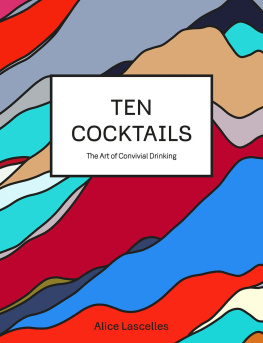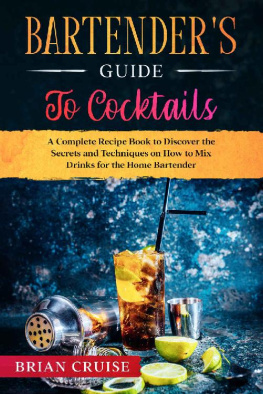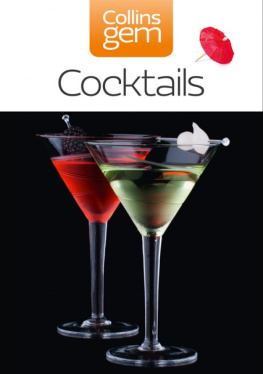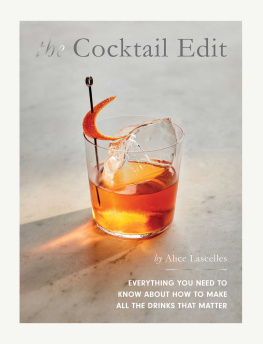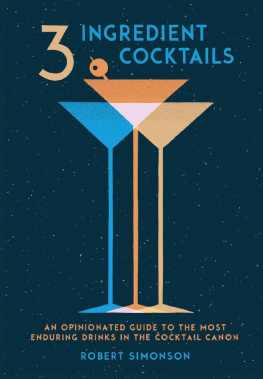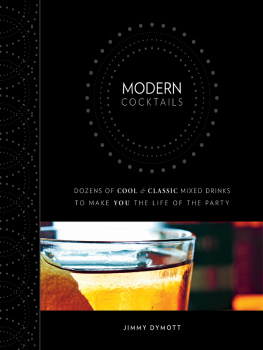Alice Lascelles writes about hard liquor for The Times and co-founded the award-winning magazine for bartenders and sommeliers, Imbibe . Her articles and columns have also appeared in The Sunday Times , Time Out and Financial Times . A second life as a musician has seen her tour with the White Stripes and record sessions for national radio. She lives in London with her husband, two sons and cocker spaniel Daisy.
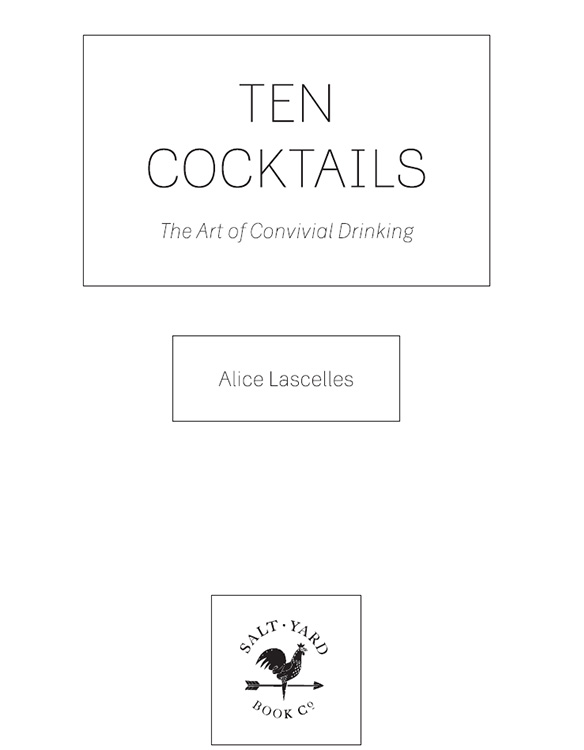
www.saltyardbooks.co.uk
First published in Great Britain in 2015 by Saltyard Books
An imprint of Hodder & Stoughton
An Hachette UK company
Copyright Alice Lascelles 2015
The right of Alice Lacelles to be identified as the Author of the Work has been asserted by her in accordance with the Copyright, Designs and Patents Act 1988.
All rights reserved. No part of this publication may be reproduced, stored in a retrieval system, or transmitted, in any form or by any means without the prior written permission of the publisher, nor be otherwise circulated in any form of binding or cover other than that in which it is published and without a similar condition being imposed on the subsequent purchaser.
The is based on Cocktail Chemistry: Parsing the Bloody Mary Adam Cole/NPR
A CIP catalogue record for this title is available from the British Library
ISBN 978 1 444 79138 9
Saltyard Books
338 Euston Road
London NW1 3BH
www.saltyardbooks.co.uk
For Al
CONTENTS

Ten Cocktails is not an exhaustive recipe book. Nor is it a definitive history of the cocktail. Its a distillation of the best stories, people, places and recipes that Ive unearthed in ten years of writing about the hard stuff: the ice block that drew crowds in Victorian London; the hidden bars of Tokyo; the whisky distillery with the finest view on Islay; and the seventeenth-century punch that caused a riot. The kind of stories, in other words, I might tell if I was mixing you a cocktail in my own kitchen.
Its also a crash course in cocktail making. Because mixing a drink is not nearly as difficult as people like to make out (as a wise soul once said: mixing cocktails is easy its being a good bartender thats hard). If you can just master the ten recipes in this book, you will have acquired almost every technique you need to make any drink that matters. Whats more, youll be armed with a repertoire of classic cocktails that are delicious, and versatile, enough to last a lifetime.
I realize there will be a few pedants ready to argue that some of the drinks in this book arent strictly speaking cocktails at all, as they dont conform to the oft-quoted formula of spirits, sugar, water and bitters which first appeared in a newspaper more than 200 years ago (a definition well return to later on in the book). But I think the rest of us know what we mean by a cocktail, and thats a mixed drink made from hard liquor.
The thing that really defines a cocktail, though, is not the list of ingredients in my opinion its the ceremony that goes into its creation. Whether thats the brandishing of a shaker, or simply the crack of an ice tray at six oclock, its a seduction that begins long before the glass reaches your lips.
And its one that can continue for a long time after too, particularly once you start exploring the panoply of wonderful spirits that the world is now producing. To that end, Ive lots of suggestions for spirit brands to try and distilleries to visit, and bars to drink in along the way.
Of course, I was never really going to succeed in sticking to just ten cocktails there are far too many good drinks out there for that. Youll find a few extra recipes tucked away at the end of each chapter, based on a vaguely similar theme. And who knows, by the time you finish this book you may feel inspired to invent a few new drinks yourself
50ml GIN
150ml TONIC WATER
Combine the ingredients in an ice-filled highball or rocks glass. Garnish with a lemon or lime wedge.
Ive had a lot of poor drinks in my time, but there is still nothing that drives me quite as crazy as a badly made gin & tonic.
Insufficient gin, flat tonic, warm tonic, not enough ice, melting ice, smelly ice, stingy glass, warm glass, stale lemon sliced so thin you could cut your tongue on it these are just some of the offences that have reduced me to silent tears at six oclock.
Im sure a lot of people think, because they make them all the time, that they know how to make a G&T. And when you look at the recipe, its understandable I mean, its only got two ingredients. Its barely even a cocktail. How could it possibly go wrong?
Yet, nightly, it does. I have friends with PhDs in paediatrics and degrees in law, who code computers for a living and possess an intimate knowledge of Wagners Ring Cycle, who can bake more than a dozen types of bread and will happily walk miles to buy an organic onion, who still , wilfully, cock this drink up on a regular basis.
For that reason, Ive decided to hold off on the Negroni Sbagliatos and Corpse Revivers for a minute and begin this book by tackling a classic so familiar its almost mundane. Because the truth is: if you can get a G&T right, youre well on the way to mastering everything you need to know about mixology.

The first mistake people make with the G&T is they get all het up about the type of gin and the brand of tonic theyre using, without first observing the most fundamental tenet of the mixed drink, which is: it must be really, really cold. If you cant get this right, then all the other ingredients are as good as irrelevant.
The most important ingredient in a G&T, therefore, is ice. A couple of melty little cubes wont cut it you need to fill the glass all the way up and then, once the tonic is in, add another cube, two if possible, until the drink resembles a teetering glacier.
But hold on, I can hear you say isnt that just a way of short-changing me on the gin? Not in the least. Going heavy on the ice actually means youll get a better drink in the long run, as the ice stays colder for longer, chilling the drink down while keeping dilution to a minimum. And the bigger those cubes are, the more efficient this process will be.
If you are stingy with the ice, all youll end up with is a drink that very quickly goes tepid, flat and watery. (I realize there are G&T drinkers of a certain generation who claim they like it like that but with all due respect they dont know what theyre talking about.)
The English in particular have a shamefully casual attitude towards ice. Open any freezer in the land and I can virtually guarantee that the ice stocks will amount to one half-filled ice tray in some over-frosted recess of the freezer, tucked snugly in alongside the mince (or, if youre my family, tucked snugly in alongside a frozen adder found under the wheels of the car). This means not only that theres never enough ice to make a round of drinks, but also that every G&T ends up tasting faintly of shepherds pie. I once even heard of a G&T that came complete with a frozen pea.
A few years ago I became so frustrated by the parlous state of the ice in my parents house that I bought everyone in my family a set of proper ice trays for Christmas. By proper I simply mean something flexible and stackable (it goes without saying you need more than one) with the largest cube size possible. Im not talking about fancy gear here this is the sort of thing you can get from a good department store for less than a fiver. All those trays that feature novelty shapes, quick-release handles, metal casing that bonds to your fingers and detachable cubes are a snare and a delusion designed by people who have clearly never made a cocktail in their life.
Next page
